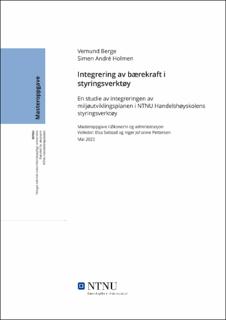| dc.contributor.advisor | Solstad, Elsa | |
| dc.contributor.advisor | Pettersen, Inger Johanne | |
| dc.contributor.author | Berge, Vemund | |
| dc.contributor.author | Holmen, Simen André | |
| dc.date.accessioned | 2022-09-16T17:20:46Z | |
| dc.date.available | 2022-09-16T17:20:46Z | |
| dc.date.issued | 2022 | |
| dc.identifier | no.ntnu:inspera:112632672:114432482 | |
| dc.identifier.uri | https://hdl.handle.net/11250/3018617 | |
| dc.description.abstract | Helt siden lanseringen av rapporten «Vår felles fremtid» i 1987, også kjent som Brundtlandrapporten, har det vært stort fokus på bærekraftig utvikling (FN, 2021). Gond, Grubnic,
Herzig og Moon (2012) påpeker at det eksisterer lite forskning på koblingen mellom
økonomistyring og bærekraft, og fremhever viktigheten av slik forskning med tanke på å
integrere bærekraft i en organisasjons styringsverktøy. På bakgrunn av dette utarbeidet vi
følgende problemstilling:
På hvilke måter integreres miljøutviklingsplanen i NTNU Handelshøyskolens styringsverktøy?
Den triple bunnlinja (Miller, 2020) ble benyttet for å belyse hvilket aspekt ved bærekraft det
fokuseres på i NTNUs miljøutviklingsplan. Videre brukte vi Malmi og Brown (2008) sitt
rammeverk for å studere hvordan miljøutviklingsplanen integreres i NTNU
Handelshøyskolens styringsverktøy. Simons’ (1995) styringsspaker ble brukt for å belyse
hvorvidt miljøutviklingsplanen brukes diagnostisk og interaktivt. Til slutt, brukte vi
institusjonell teori i analysen av hvorvidt integreringen av miljøutviklingsplanen påvirkes av
institusjonelle krefter.
For å besvare problemstillingen har vi gjennomført en casestudie av NTNU
Handelshøyskolen, hvor vi har samlet inn empirisk data gjennom individuelle intervju med tre
ledere og fokusgruppeintervju med tre ansatte ved NTNU Handelshøyskolen. Videre har vi
gjennomført en spørreundersøkelse blant studentene ved instituttet, i tillegg til at vi supplerte
med en studie av dokumenter.
Våre funn viser at det eksisterer institusjonelle krefter i form av tvangsmessig isomorfisme,
som ligger til grunn for integreringen av miljøutviklingsplanen ved NTNU Handelshøyskolen.
Et annet sentralt funn viser at miljøutviklingsplanen i all hovedsak brukes interaktivt (Simons,
1995) på virksomhetsstyringsnivå, mens det er liten grad av involvering av ansatte og
studenter. Dette viser i tråd med Meyer og Rowan (1977) en dekobling i organisasjonen. Med
utgangspunkt i styringspakken til Malmi og Brown (2008), viser funnene våre at integreringen
av miljøutviklingsplanen påvirkes av verdier og klaner. I tillegg viser det seg at
miljøutviklingsplanen består av ikke-finansielle mål, og at det ikke er laget noen retningslinjer
og prosedyrer knyttet til bruken av miljøutviklingsplanen. Avslutningsvis viser funnene våre
at miljøutviklingsplanen integreres i planstyringen som foregår i organisasjonen. | |
| dc.description.abstract | The launch of “Our common future” in 1987, also known as the Brundtland Report, triggered
a focus on sustainable development that has intensified over the past three decades (FN,
2021). Still, as Gond, Grubnic, Herzig and Moon (2012) point out, research on the topic is
modest when it comes to the link between management control systems and sustainability.
They emphasize the importance of research that focuses on the integration of sustainability as
a part of an organization`s management tools. This call for research motivated us to answer
the following research question:
In what ways does NTNU Business School integrate the environmental development plan into their management control tools?
The triple bottom line (Miller, 2020) was used to explore which aspect of sustainability that
NTNU`s environmental development plan focuses on. Going further, we employed Malmi
and Brown`s (2008) framework to study how NTNU Business School integrate the
environmental development plan into their management control tools. Simons` (1995) Levers
of Control were used to shed light on whether the environmental development plan is used
diagnostically and interactively. Finally, we employed institutional theory in the analysis of
whether the integration of the environmental development plan is affected by institutional
forces. To answer the research question, we have conducted a case study of NTNU Business
School. We have conducted individual interviews with three managers and focus group
interviews with three employees at NTNU Business School. Furthermore, we conducted a
survey among the students, in addition to a document study.
Our findings show that there are institutional forces in the form of coercive isomorphism,
which form the basis for the integration of the environmental development plan at NTNU
Business School. Another key finding shows that the environmental development plan is
mainly used interactively at the governance level, while there is little involvement of
employees and students in the organisation. In line with Meyer and Rowan (1977), this shows
a decoupling in the organization. Based on the management package of Malmi and Brown
(2008), our findings show that the integration of the environmental development plan is
affected by values and clans. In addition, it turns out that the environmental development plan
consists of non-financial goals, and that there are no guidelines and procedures in connection
with the use of the environmental development plan. Finally, our findings show that the
environmental development plan is integrated into the management that takes place in the
organization when it comes to planning. | |
| dc.language | nob | |
| dc.publisher | NTNU | |
| dc.title | Integrering av bærekraft i styringsverktøy | |
| dc.type | Master thesis | |
